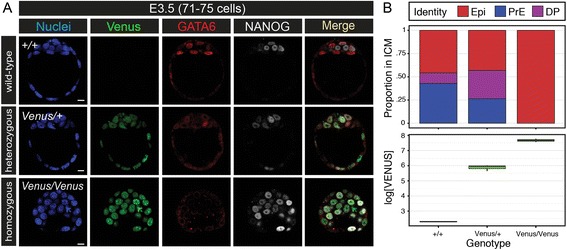Fig. 3.

Gata6 H2B-Venus/H2B-Venus homozygous blastocysts exhibit a Gata6 null phenotype. a Immunofluorescence for GATA6 and NANOG protein in Gata6 +/+ (+/+; wild-type) Gata6 H2B-Venus/+ (Venus/+; heterozygous) and Gata6 H2B-Venus/H2B-Venus (Venus/Venus; homozygous) blastocysts at E3.5. Gata6 H2B-Venus/H2B-Venus mutants did not express GATA6 protein, and instead expressed NANOG in all ICM cells even though the reporter is transcriptionally active. Nuclei are stained with Hoechst (blue). b Quantification of cells with epiblast (EPI, NANOG+) versus PrE (PRE, GATA6+) identity at E3.5. Cells that did not adopt a clear identity were marked as double positive (DP) for both NANOG and GATA6. Gata6 H2B-Venus/H2B-Venus homozygotes did not specify PrE, and Gata6 H2B-Venus/+ heterozygotes had a relatively reduced number of cells with PrE identity and increased numbers of double positive cells with undecided identity. Gata6 H2B-Venus/H2B-Venus embryos with both alleles of the reporter, and effectively a Gata6 null, had higher levels of Venus expression compared to Gata6 H2B-Venus/+ embryos with only one reporter allele. This would suggest that GATA6 either does not regulate, or negatively feeds back on, Gata6 gene expression.
